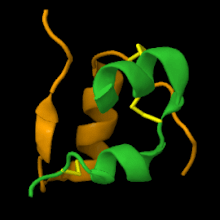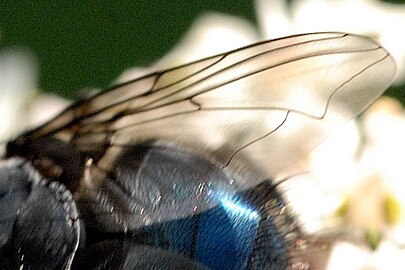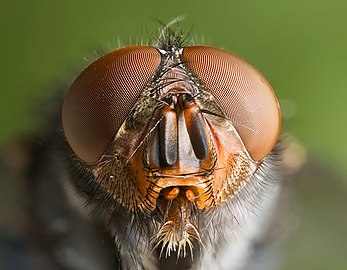Calliphora vomitoria
| Calliphora vomitoria | |
|---|---|

| |
| Female | |
| Scientific classification | |
| Domain: | Eukaryota |
| Kingdom: | Animalia |
| Phylum: | Arthropoda |
| Class: | Insecta |
| Order: | Diptera |
| Family: | Calliphoridae |
| Genus: | Calliphora |
| Species: | C. vomitoria
|
| Binomial name | |
| Calliphora vomitoria | |
| Synonyms[1][2] | |
| |
Calliphora vomitoria, known as the blue bottle fly,[3] orange-bearded blue bottle,[4] or bottlebee is a common blow fly, a species in the family Calliphoridae. Calliphora vomitoria is the type species of the genus Calliphora. It is relatively common throughout many widespread regions throughout the world. They are fairly large flies, nearly twice the size of the housefly. They can be easily identified by their shiny, blue bodies.
While adult flies feed on nectar, the blue bottle fly females deposit their eggs on rotting corpses, making them important forensic insects, as their eggs and timing of oviposition can be used to estimate time of death.
Description

Blue bottle flies are typically 10–14 millimetres (0.4–0.6 in) long, almost twice the size of a housefly. The head and thorax are dull gray, and the back of the head has long yellow-orange setae.[5][6] The abdomen is bright metallic blue with black markings. Its body and legs are covered with black bristly hairs. It has short, clubbed antennae and four tarsi per leg. The eyes are red and the wings are transparent. The legs and antennae are black and pink. The chest is bright purple and has spikes for protection from other flies.[7][8]
Distribution and habitat
Calliphora vomitoria occurrs in most of Europe, Alaska, Greenland, the south of Mexico, Virginia, Hawaii, and southern Africa.[9][10] It prefers higher elevations relative to other Calliphoridae species, such as Lucilia sericata and Chrysomya albiceps. They are among the most abundant flies found in these regions.[11]
Temperature has a significant effect on distribution. As is the case with most flies, C. vomitoria are found most abundantly during spring and summer, and least abundant during fall and winter.[12] The preferred habitat of C. vomitoria varies depending on the season. During winter and summer, they can be found mostly in rural areas (and riparian areas to a lesser extent). During spring and fall, they are found in riparian areas.[13]
Life cycle

Blue bottle flies have the complete cycle of egg, larva, pupa, and adult. Development usually takes around 2 weeks. A female blue bottle fly lays her eggs where she feeds, usually in decaying meat, garbage, or feces. Pale whitish larvae, commonly called maggots, soon hatch from the eggs and immediately begin feeding on carcasses of dead animals and on the decomposing matter where they were hatched.[14] After a few days of feeding, they are fully grown. At that time they crawl away to a drier place where they burrow into soil or similar matter and pupate into tough brown cocoons. The pupal stage is the longest stage before they emerge.[12]
After two or three weeks, the adults emerge to mate, beginning the cycle again. During cold weather, pupae and adults can hibernate until higher temperatures revive them.[8]
While it is commonly believed that programmed cell death and apoptosis are the same, they are not always so. At the beginning of metamorphosis, salivary gland cells of Caliliphora vomitoria larvae are self-programmed to destroy. After enough feeding, the larvae come to rest and an initial protein synthesis stage surges, culminating in the production of high amounts of protein. This occurs from day 1 to about day 8. Then, on day 9, cell death occurs. This pattern of synthesis and destruction is not to be confused with apoptosis, as no DNA degeneration is seen and cells are shown to vacuolate and swell (compared to condense and shrink in the case of apoptosis). Instead, selective expression and DNA synthesis is seen to support programmed cell death.[15]

Diet
Like other blowflies, C. vomitoria colonize animal remains, including humans. While adult C. vomitoria feed on nectar, the larvae feed on corpses, the medium in which they grow. However, it has been shown that when processed substrates, such as beef and turkey, are consumed (rather than unprocessed substrates such as liver), they experienced much better growth. As such, C. vomitoria is best characterized as a specialist. Its close relative, Calliphora vicina, is a generalist, being able to utilize mixed substrates.[16] In the case of overcrowding, C. vomitoria competition results in compensation by increased speed of development, leading to smaller larvae and adults. This has complications in forensics because different parts of the body would grow at different rates.[17] Additionally, it has been shown that the fly larvae are able to colonize even buried remains. Growth rates between surface and buried larvae grew at a similar pace.[18] Usually, these flies lay their eggs around wounds on fresh corpses shortly after death. Right before the pupal stage, the fly larvae leaves the carrion can burrow into the soil in order to pupate. Then, adult flies emerge.[12]

Bluebottle fly adults feed on nectar, and they are pollinators of flowers. They are especially attracted to flowers that have strong odors, such as those that have adapted to smell like rotting meat. They mainly pollinate skunk cabbage (Symplocarpus foetidus), American pawpaw (Asimina triloba), dead horse arum (Helicodiceros muscivorus), goldenrod and some species of the carrot family.[19] These insects tend to fly in packs in order to detect possible food sources more efficiently. If one fly detects food, it disperses a pheromone, which will alert the others to the meal.[8]
Parental care
Blow flies like C. vomitoria lay their eggs at carrion sites, which are scarce in most places so they end up with lots of eggs on corpses, laid by different species. As a result, high larval density arises. In fact, when there are many other individuals around the site, pregnant females increase oviposition, likely because of contact and chemical stimulation.[20] The large number of larvae, though, actually ends up being beneficial in the group. The larvae feed by secretion of enzymes that break down tissues of the corpse, so by aggregating in large numbers these secretions are more effective, leading to easier feeding. Additionally, the large aggregation helps generate heat and keep the larvae warm, as the flies generally prefer warmer temperature. One complication with these benefits is that competition is still a factor, as larvae on the periphery may be left out of the feeding, and by the end of the developmental cycle they emerge undernourished and undersized.[17]
Physiology
Night flight
It has been suggested that C. vomitoria rarely fly at night, regardless of the presence of an existing corpse. This potentially suggests that they do not deposit eggs on corpses during the night. Its application to forensic science, stems from the idea that the time of oviposition can then be determined.[21]

Brain
The median neuro-secretory cells (MNC) of the brain of Calliphora species contain peptide hormones that resemble insulin. This was proven when researchers were able to bind these insulin-like peptides with antibodies of bovine insulin. This shows that an insect hormone can be structurally analogous to a prominent mammalian hormone[17] and it brings up the possibility of these insulin-like or polypeptide-like materials serving as central nervous system regulatory hormones before they were metabolic regulatory hormones.[22][23]
Adhesive organ
On the terminal region of the 5th tarsal segment, the C. vomitoria contain pulvilli, which are the cushion-like hairy feet on insects and many arthropods located at base of their 2 claws. The hair that project from the ventral surface is the key for the adhesion abilities of these flies. Additionally, they have large claws that help to hold on to irregular surfaces to prevent falling. C. vomitoria, like other blowflies, also secrete non-volatile lipids through the hairs that are important for further adhesion. By a combination of the physical grip of the claws and hairs and the surface tension created by the lipid secretions, they are able to adhere to smooth surfaces with ease. The force of adhesion between vertical and lateral pulls has been measured, and it has been concluded that lateral pulls required much greater forces. [24][25]
Interaction with humans
Forensics
These flies are among the most important insect evidence in forensic science.[12] Calliphora species in particular are the most important in temperate regions because of their growth rate in accordance to temperature. By knowing the temperature, the time since eggs were laid can be estimated. In addition, C. vomitoria has higher threshold temperature than many species; likewise, it is present in many regions. There is a limit to their usage, though, as few species can survive in cold temperatures; most cannot continue development unless it is warmer than roughly 35 degrees Fahrenheit[26].
Carcasses are divided into several different stages: stage of decomposition, fresh stage, bloated stage, active decay stage, advanced decay stage, and remains stage. Adult C. vomitoria first starts to appear at carcasses during the bloated stage, followed by larvae 1 to 3 days after. During the active decay stage, blow fly larvae population reaches its peak.[27]
In buried corpses, the timing and how body was stored can also be collected through the identification of C. vomitoria in these substrates.[18] The study of these flies, however, are limited to areas where entomologists are readily available, as each region may contain the same species but with different life histories. In order for C. vomitoria to provide useful data to investigators, these restrictions should be considered, so the proper time of colonization (TOC) and post mortem interval (PMI) can be established.[12]

This bluebottle fly can also cause human or animal myiasis (parasitization in a living individual). Forensic scientists sometimes identify it in the course of their work, particularly in the case of an autopsy of a neglected child.[28][29]
Identification
C. vomitoria is often not the only species present at carrion, so some process of identification of the correct species is needed in order to avoid false estimates of the time of death due to them having different developmental cycles. In the past, simple morphological differences are used to differentiate between species. However, it is very difficult in crime scenes because more often than not these sites are not ideal, with preservation of insect species far from good. Some methods that can best differentiate between the species are DNA, mitochondrial DNA, and the COI gene. The COI gene used in conjunction with the SfcI restriction enzyme has been shown to be a relatively fast and simple method of distinguishing between blowfly species with good accuracy.[30]
Post mortem interval (PMI)
Post mortem interval is the time between death and discovery of a corpse. C. vomitoria is important for PMI because they are often one of the first to lay eggs on the corpse. There are two ways of estimating PMI. One is killing the larvae, and then comparing the larvae's length and temperature to those in the standardized data. Another way to calculate PMI is to calculate accumulated degree hours/days (ADH/D) that a larvae needs to reach a certain developmental stage. The later method is the more widely accepted way to estimate PMI.[17]
Legal importance
Calliphora vomitoria is considered one of the most important flies in medico-legal cases. As one of the most abundant flies and their tendency to be first on the case (carrion), they are very useful in legal investigations. Other Calliphora species, while important as parasites of humans, are not as important simply because they're less often found. However, there is not a clear consensus on fly distribution, as different areas attracts different species of flies, and so field research should be conducted in local areas to confirm the presence or absence of these important forensic resources. [13]
Pollination of crops
Calliphora vomitoria is frequently used as pollinators of different crops, working especially well with strongly scented crops. The flies feed on the nectar of these crops and then proceed to spread their seeds when they fly. These pollination events can lead to seed infestation of cauliflower. [31]
Gallery
References
- ^ "Calliphora vomitoria". Integrated Taxonomic Information System. Retrieved May 31, 2008.
- ^ Kurahshi, Hiromu (May 28, 2007). "109. Family CALLIPHORIDAE". Australasian/Oceanian Diptera Catalog. Hawaii Biological Survey. Retrieved May 31, 2008.
- ^ "Species Calliphora vomitoria - Blue Bottle Fly - BugGuide.Net". bugguide.net. Retrieved 10 November 2019.
- ^ "Calliphora vomitoria". National Biodiversity Network. Retrieved 10 November 2019.
- ^ Terry Whitworth. Keys to genera and species of blow flies (Diptera: Calliphoridae) of America north of Mexico. Proceedings of The Entomological Society of Washington. 108 (3), s. 689-725, 2006.
- ^ Krzysztof Szpila: Key for identification of European and Mediterranean blowflies (Diptera, Calliphoridae) of forensic importance. Adult flies
- ^ Jean-Henri Fabre, 1907 - La mouche verte et violette
- ^ a b c Michael Chinery, Insectes de France et d'Europe occidentale, Paris, Flammarion, 2012, (ISBN 978-2-0812-8823-2), p. 214-215
- ^ Fauna europaea
- ^ Calalogue of life
- ^ Baz, Arturo; Cifrián, Blanca; Díaz-äranda, Luisa María; Martín-Vega, Daniel (2007-01-01). "The distribution of adult blow-flies (Diptera: Calliphoridae) along an altitudinal gradient in Central Spain". Annales de la Société Entomologique de France (N.S.). 43 (3): 289–296. doi:10.1080/00379271.2007.10697524. ISSN 0037-9271.
- ^ a b c d e Ames, C.; Turner, B. (2003). "Low temperature episodes in development of blowflies: implications for postmortem interval estimation". Medical and Veterinary Entomology. 17 (2): 178–186. doi:10.1046/j.1365-2915.2003.00421.x. ISSN 1365-2915.
- ^ a b Brundage, Adrienne; Bros, Shannon; Honda, Jeffrey Y. (2011-10-10). "Seasonal and habitat abundance and distribution of some forensically important blow flies (Diptera: Calliphoridae) in Central California". Forensic Science International. 212 (1): 115–120. doi:10.1016/j.forsciint.2011.05.023. ISSN 0379-0738.
- ^ Progressive Pest Control
- ^ Bowen, I. D.; Morgan, S. M.; Mullarkey, K. (1993-01-01). "Cell death in the salivary glands of metamorphosing calliphora vomitoria". Cell Biology International. 17 (1): 13–34. doi:10.1006/cbir.1993.1002. ISSN 1065-6995.
- ^ Niederegger, Senta; Wartenberg, Nelly; Spiess, Roland; Mall, Gita (2013-08-01). "Influence of food substrates on the development of the blowflies Calliphora vicina and Calliphora vomitoria (Diptera, Calliphoridae)". Parasitology Research. 112 (8): 2847–2853. doi:10.1007/s00436-013-3456-6. ISSN 1432-1955.
- ^ a b c d Ireland, Sarah; Turner, Bryan (2006-06-02). "The effects of larval crowding and food type on the size and development of the blowfly, Calliphora vomitoria". Forensic Science International. 159 (2): 175–181. doi:10.1016/j.forsciint.2005.07.018. ISSN 0379-0738.
- ^ a b Gunn, Alan; Bird, Jerry (2011-04-15). "The ability of the blowflies Calliphora vomitoria (Linnaeus), Calliphora vicina (Rob-Desvoidy) and Lucilia sericata (Meigen) (Diptera: Calliphoridae) and the muscid flies Muscina stabulans (Fallén) and Muscina prolapsa (Harris) (Diptera: Muscidae) to colonise buried remains". Forensic Science International. 207 (1): 198–204. doi:10.1016/j.forsciint.2010.10.008. ISSN 0379-0738.
- ^ Pollinator in Encyclopedia of life National Biological Information Infrastructure (NBII)
- ^ Barton Browne, L.; Bartell, R. J.; Shorey, H. H. (1969-06-01). "Pheromone-mediated behaviour leading to group oviposition in the blowfly Lucilia cuprina". Journal of Insect Physiology. 15 (6): 1003–1014. doi:10.1016/0022-1910(69)90140-1. ISSN 0022-1910.
- ^ Wooldridge, J.; Scrase, L.; Wall, R. (2007-10-25). "Flight activity of the blowflies, Calliphora vomitoria and Lucilia sericata, in the dark". Forensic Science International. 172 (2): 94–97. doi:10.1016/j.forsciint.2006.12.011. ISSN 0379-0738.
- ^ Duve, H.; Thorpe, A.; Neville, R.; Lazarus, N. R. (1981-09-01). "Isolation and partial characterization of pancreatic polypeptide-like material in the brain of the blowfly Calliphora vomitoria". Biochemical Journal. 197 (3): 767–770. doi:10.1042/bj1970767. ISSN 0264-6021.
- ^ Duve, H.; Johnsen, A. H.; Scott, A. G.; Yu, C. G.; Yagi, K. J.; Tobe, S. S.; Thorpe, A. (1993-03-15). "Callatostatins: neuropeptides from the blowfly Calliphora vomitoria with sequence homology to cockroach allatostatins". Proceedings of the National Academy of Sciences. 90 (6): 2456–2460. doi:10.1073/pnas.90.6.2456. ISSN 0027-8424. PMID 8460157.
- ^ Walker, G.; Yulf, A. B.; Ratcliffe, J. (1985). "The adhesive organ of the blowfly, Calliphora vomitoria: a functional approach (Diptera: Calliphoridae)". Journal of Zoology. 205 (2): 297–307. doi:10.1111/j.1469-7998.1985.tb03536.x. ISSN 1469-7998.
- ^ Walker, G. (1993-01-01). "Adhesion to smooth surfaces by insects — a review". International Journal of Adhesion and Adhesives. 13 (1): 3–7. doi:10.1016/0143-7496(93)90002-Q. ISSN 0143-7496.
- ^ Kamal, Adel S. (1958-05-01). "Comparative Study of Thirteen Species of Sarcosaprophagous Calliphoridae and Sarcophagidae (Diptera) I. Bionomics". Annals of the Entomological Society of America. 51 (3): 261–271. doi:10.1093/aesa/51.3.261. ISSN 0013-8746.
- ^ Matuszewski, Szymon; Bajerlein, Daria; Konwerski, Szymon; Szpila, Krzysztof (2008-09-18). "An initial study of insect succession and carrion decomposition in various forest habitats of Central Europe". Forensic Science International. 180 (2): 61–69. doi:10.1016/j.forsciint.2008.06.015. ISSN 0379-0738.
- ^ Benecke M, Lessig R, « Child neglect and forensic entomology », Forensic Sci Int, vol. 120, no 1-2, 2001, p. 155-9.
- ^ Bowen, Ivor D.; Mullarkey, Kate; Morgan, S. M. (1996). "Programmed cell death during metamorphosis in the blow-fly Calliphora vomitoria". Microscopy Research and Technique. 34 (3): 202–217. doi:10.1002/(SICI)1097-0029(19960615)34:33.0.CO;2-R. ISSN 1097-0029.
- ^ Ames, Carole; Turner, Bryan; Daniel, Barbara (2006-12-20). "The use of mitochondrial cytochrome oxidase I gene (COI) to differentiate two UK blowfly species – Calliphora vicina and Calliphora vomitoria". Forensic Science International. 164 (2): 179–182. doi:10.1016/j.forsciint.2006.01.005. ISSN 0379-0738.
- ^ Wolf, Jan M. Van Der; Zouwen, Patricia S. Van Der (2010). "Colonization of Cauliflower Blossom (Brassica oleracea) by Xanthomonas campestris pv. campestris, via Flies (Calliphora vomitoria) Can Result in Seed Infestation". Journal of Phytopathology. 158 (11–12): 726–732. doi:10.1111/j.1439-0434.2010.01690.x. ISSN 1439-0434.





